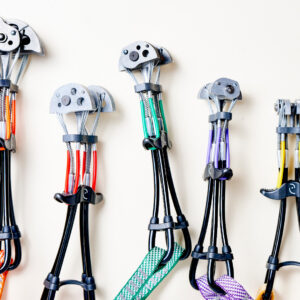Trust Your Gear, Trust Your Placements
Placing rock climbing cams is both a science and an art—and mastering it can be the difference between a bomber placement and a sketchy, heart-stopping fall.
If you’re new to trad climbing, you might be wondering:
✅ How do I know if my cam will actually hold?
✅ What makes a placement solid vs. dangerous?
✅ Are Totem Cams really better for tricky placements?
This guide breaks down five pro-level tips for placing cams confidently and securely, so you can focus on climbing instead of second-guessing your gear.
1. Pick the Right Cam for the Crack Size
Choosing the right-sized cam is half the battle when it comes to placing protection.
 The Golden Rule: 50-70% Retraction
The Golden Rule: 50-70% Retraction
- The cam’s lobes should be retracted about halfway to 70% when placed.
- Too open (over-cammed) = Hard to remove, may get stuck.
- Too closed (under-cammed) = Less secure, easier to pull out.
| Crack Size | Best Cam Size |
|---|---|
| Thin Fingers | Totem Cam Blue or Black |
| Fingers | Totem Cam Yellow |
| Wide Fingers | Totem Cam Purple |
| Hands | Totem Cam Green |
| Wide Hands / Fist | Totem Cam Red |
💡 Pro Tip: If you’re between two sizes, go slightly smaller for a better fit. Check out Totem Cams specs here.
2. Look for Solid Rock & Good Surface Contact
Even the best cam placement won’t hold if the surrounding rock is weak.
✅ Choose clean, solid rock—avoid loose or hollow-sounding rock.
✅ Ensure all four lobes make good contact with the crack walls.
✅ Check for flaring cracks—cams don’t hold well in outward-flaring cracks.
💡 Why Totem Cams Work Best: Unlike traditional cams, Totem Cams use a Direct Loading System, distributing force evenly across all lobes—this means they perform better in marginal placements like pin scars or flared cracks.
3. Align the Cam for the Fall Direction
One of the most common mistakes in trad climbing is placing a cam that isn’t aligned with the expected fall direction.
How to Place Cams for Fall Safety:
🔹 For Vertical Cracks: The cam stem should be pointing downward, in line with the expected pull direction.
🔹 For Horizontal Cracks: Rotate the cam so the stem points toward the anticipated fall direction.
🔹 For Overhanging Routes: Extend your placement with a long sling to prevent cam walking.
💡 Why This Matters: If the cam stem points straight out from the crack, it’s more likely to wiggle loose or “walk” deeper into the crack.
4. Extend Your Placements to Prevent Walking
Cams can walk deeper into a crack due to rope movement, potentially shifting into an unstable position.
✅ Use an alpine draw or sling (60cm recommended) instead of clipping the rope directly into the cam.
✅ Place the cam deeply enough that it won’t shift easily, but not so deep that it’s impossible to remove.
💡 Why Totems Help: Thanks to their flexible stem, Totem Cams are less prone to walking than stiffer-stemmed cams like Black Diamond Camalots.
5. Test Your Placement Before You Trust It
Before you climb past your placement, always test it:
How to Check if Your Cam is Bomber:
🔹 Tug on the cam lightly to make sure it’s set.
🔹 Gently pull downward to simulate a fall force.
🔹 Check if the lobes stay in place or shift/move.
✅ If it stays in place → Good placement!
❌ If it shifts, repositions, or pulls out → Reassess and find a better spot.
💡 Pro Tip: In questionable placements, use a nut or another cam nearby for redundancy.
Bonus: How to Place Cams in Tricky Situations
Sometimes, you won’t have a perfect textbook placement. Here’s how to handle difficult cracks:
Flared Cracks (Wider on One Side)
- Traditional cams don’t hold well in flaring placements, but Totem Cams excel because they distribute force directly to the lobes.
Shallow Cracks
- Use a narrow-headed cam like a Totem or a small offset cam for better engagement.
Horizontal Cracks
- Always extend with a sling to reduce walking.
Final Thoughts: Master Cam Placement & Climb with Confidence
Placing rock climbing cams correctly is a skill that takes practice, but by following these tips, you’ll be able to set bomber placements that you can trust.
✅ Choose the right size (50-70% retracted lobes)
✅ Place in solid rock with full lobe contact
✅ Align the cam for fall direction
✅ Extend placements to prevent walking
✅ Test before committing to the move
🚀 Want to upgrade your trad rack? Shop Totem Cams now and experience the best cams for tricky placements!
